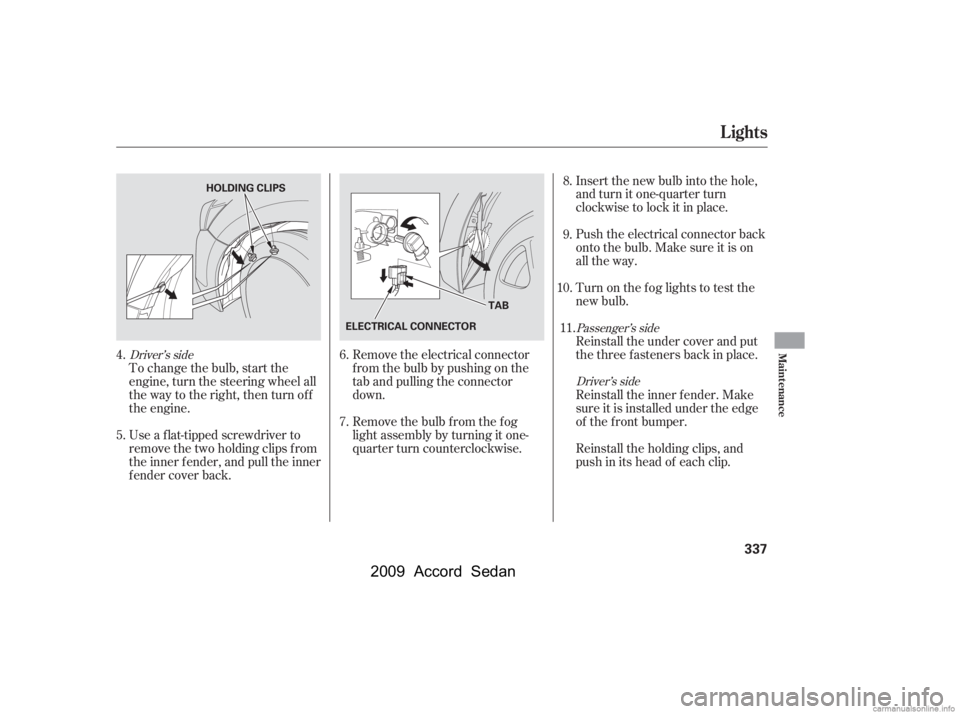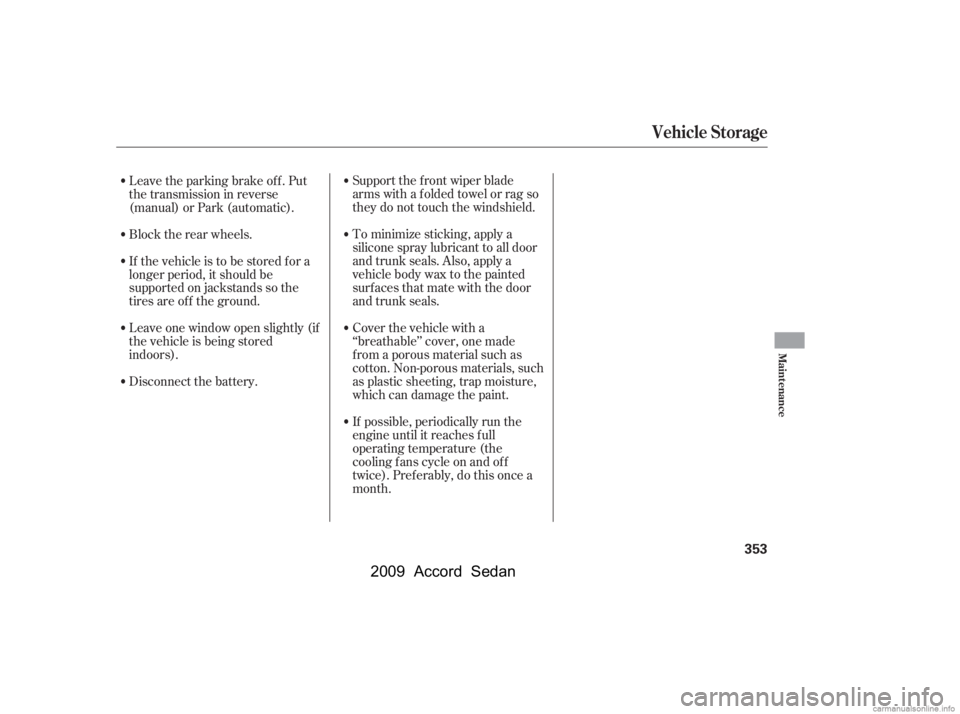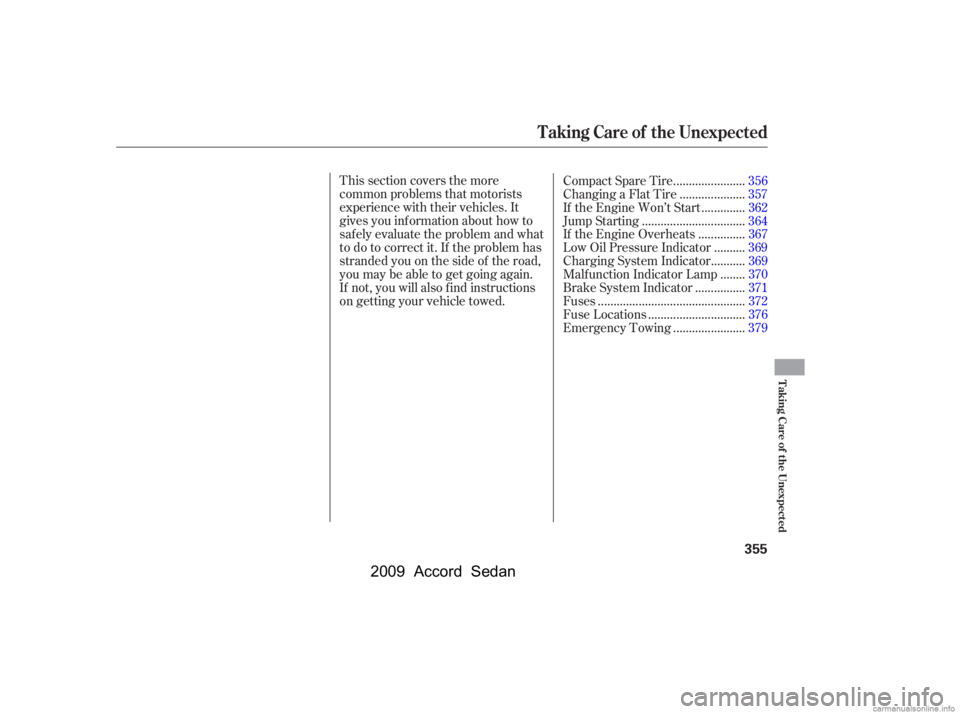Page 340 of 420

To change the bulb, start the
engine, turn the steering wheel all
the way to the right, then turn off
the engine.
Use a f lat-tipped screwdriver to
remove the two holding clips f rom
the inner f ender, and pull the inner
f ender cover back.Insert the new bulb into the hole,
and turn it one-quarter turn
clockwise to lock it in place.
Push the electrical connector back
onto the bulb. Make sure it is on
all the way.
Reinstall the under cover and put
the three f asteners back in place.
Reinstall the inner f ender. Make
sure it is installed under the edge
of the f ront bumper.
Reinstall the holding clips, and
push in its head of each clip.
Remove the electrical connector
f rom the bulb by pushing on the
tab and pulling the connector
down.
Remove the bulb f rom the f og
light assembly by turning it one-
quarter turn counterclockwise. Turn on the f og lights to test the
new bulb.
6.
7. 8.
4.
5. 9.
10. 11.
Passenger’s side
Driver’s side
Driver’s side
Lights
Maint enance
337
ELECTRICAL CONNECTOR
TAB
HOLDING CLIPS
�\f���—�\f���—�\f���y�
�����������\f�y���
�)���\f���
�\f�y�\f�������y
2009 Accord Sedan
Page 347 of 420

�Î
�Î
�Î�Î
The following chart shows the
recommended cold tire pressures f or
most normal driving conditions.
If you check air pressures when the
tires are hot [driven f or several miles
(kilometers)], you will see readings 4
to6psi(30to40kPa,0.3to0.4
kgf /cm ) higher than the cold
readings.Thisisnormal.Donotlet
air out to match the recommended
cold air pressure. The tire will be
underinf lated.
While tubeless tires have some
ability to self -seal if they are
punctured, you should look closely
for punctures if a tire starts losing
pressure.
Youshouldgetyourowntire
pressure gauge and use it whenever
you check your tire pressures. This
will make it easier f or you to tell if a
pressure loss is due to a tire problem
and not due to a variation between
gauges. Thecompactsparetirepressureis:
For convenience, the recommended
tire sizes and cold tire pressures are
on a label on the driver’s doorjamb.
For additional inf ormation about
your tires, see page .
388
Cold Tire Pressure
for Normal Driving Tire Size
Tire Size Cold Tire Pressure
for Normal Driving
Front/Rear:
Front/Rear:
1:
2: EX, EX-L Front/Rear:
LX, LX-P
V6 models
2.4
engine models
1
2
Recommended Tire Pressures
Tires
344
60 psi (420 kPa , 4.2 kgf/cm)P225/50R17 93V 32 psi (220 kPa ,2.2 kgf/cm
)
30 psi (210 kPa , 2.1 kgf/cm
)
P215/60R16 94H P225/50R17 93V
32 psi (220 kPa ,2.2 kgf/cm
)
�\f���—�\f���—�\f���y�
���������
���y���
�)���\f���
�\f�y�\f�������y
2009 Accord Sedan
Page 348 of 420

Your tires have wear indicators
molded into the tread. When the
tread wears down, you will see a 1/2
inch (12.7 mm) wide band across the
tread. This shows there is less than
1/16 inch (1.6 mm) of tread lef t on
the tire.
A tire this worn gives very little
traction on wet roads. You should
replace the tire if you can see three
or more tread wear indicators.
Every time you check inf lation, you
should also examine the tires f or
damage, f oreign objects, and wear.
Youshouldlookfor:
Bumps or bulges in the tread or
side of the tire. Replace the tire if
youfindeitherof theseconditions.
Cuts, splits, or cracks in the side
of the tire. Replace the tire if you
can see f abric or cord.
Excessive tread wear.
We strongly recommend that you do
not drive faster than the posted
speed limits and conditions allow. If
you ever drive in a sanctioned
competitive event at sustained high
speeds (over 118 mph or 190 km/h),
be sure to adjust the cold tire
pressuresasshownbelow.If youdo
not, excessive heat can build up and
cause sudden tire f ailure.
Tire pressure f or high speed driving
is the same as f or normal driving.Tire Size Cold Tire Pressure
V6 models only
2.4
engine models
Tire Inspection
High Speed Driving
Tires
Maint enance
345
TREAD WEAR INDICATOR INDICATOR LOCATION MARK
P225/50R17 93V 35 psi (240 kPa ,
2.4 kgf/cm
)
�\f���—�\f���—�\f���y�
�������������y���
�)���\f���
�\f�y�\f�����\f�y
2009 Accord Sedan
Page 354 of 420

�µ
Check the condition of the battery
monthlybylookingatthetest
indicator window. The label on the
battery explains the test indicator’s
colors. Check the terminals f or corrosion (a
white or yellowish powder). To
remove it, cover the terminals with a
solution of baking soda and water. It
will bubble up and turn brown. When
this stops, wash it of f with plain
water. Dry off the battery with a
cloth or paper towel. Coat the
terminals with grease to help prevent
f uture corrosion. Battery posts,
terminals, and related accessories
contain lead and lead compounds.
If you need to connect the battery to
a charger, disconnect both cables to
prevent damaging your vehicle’s
electrical system. Always disconnect
the negative ( ) cable first, and
reconnect it last.
If additional battery maintenance is
needed, see your dealer or a
qualif ied mechanic.
The location of the test indicator
window varies between
manuf acturers.
CONT INUED
WARNING:
Wash your hands af ter handling.
Checking the Battery
Maint enance
351
TEST INDICATOR WINDOW V6 modelsTEST INDICATOR WINDOW
2.4
engine models
�\f���—�\f���—�\f���y�
���������
�\f�y���
�)���\f���
�\f�y�\f�������y
2009 Accord Sedan
Page 356 of 420

Support the f ront wiper blade
arms with a f olded towel or rag so
they do not touch the windshield.
To minimize sticking, apply a
silicone spray lubricant to all door
and trunk seals. Also, apply a
vehiclebodywaxtothepainted
surfaces that mate with the door
and trunk seals.
Cover the vehicle with a
‘‘breathable’’ cover, one made
f rom a porous material such as
cotton. Non-porous materials, such
as plastic sheeting, trap moisture,
which can damage the paint.
Leave the parking brake off. Put
the transmission in reverse
(manual) or Park (automatic).
If possible, periodically run the
engine until it reaches f ull
operating temperature (the
cooling f ans cycle on and of f
twice). Pref erably, do this once a
month.
Block the rear wheels.
If the vehicle is to be stored f or a
longer period, it should be
supported on jackstands so the
tires are of f the ground.
Leave one window open slightly (if
the vehicle is being stored
indoors).
Disconnect the battery.
Vehicle Storage
Maint enance
353
�\f���—�\f���—�\f���y�
�������������y���
�)���\f���
�\f�y�\f�������y
2009 Accord Sedan
Page 358 of 420

This section covers the more
common problems that motorists
experience with their vehicles. It
gives you inf ormation about how to
safely evaluate the problem and what
to do to correct it. If the problem has
stranded you on the side of the road,
you may be able to get going again.
If not, you will also f ind instructions
on getting your vehicle towed.......................
Compact Spare Tire .356
....................
Changing a Flat Tire .357
.............
If the Engine Won’t Start .362
................................
Jump Starting .364
..............
If the Engine Overheats .367
.........
Low Oil Pressure Indicator .369
..........
Charging System Indicator .369
.......
Malf unction Indicator Lamp .370
...............
Brake System Indicator .371
..............................................
Fuses .372
..............................
Fuse Locations .376
......................
Emergency Towing .379
Taking Care of the Unexpected
T aking Care of t he Unexpect ed
355
�\f���—�\f���—�\f���y�
�������������y���
�)���\f���
�\f�y�\f�����\f�y
2009 Accord Sedan
Page 365 of 420

Diagnosing why the engine won’t
start f alls into two areas, depending
on what you hear when you turn the
ignition switch to the START (III)
position:You hear nothing, or almost
nothing. The engine’s starter
motor does not operate at all, or
operates very slowly.
You can hear the starter motor
operating normally, or the starter
motor sounds like it is spinning
f aster than normal, but the engine
does not start up and run. When you turn the ignition switch to
the START (III) position, you do not
hear the normal noise of the engine
trying to start. You may hear a
clicking sound, a series of clicks, or
nothing at all.
Check these things:
Check the transmission interlock.
If you have a manual transmission,
the clutch pedal must be pushed
all the way to the f loor or the
starter will not operate. With an
automatic transmission, it must be
in Park or neutral.
Turn the ignition switch to the ON
(II) position. Turn on the
headlights, and check their
brightness. If the headlights are
very dim or do not come on at all,
the battery is discharged. See on page . Turn the ignition switch to the
START (III) position. If the
headlights do not dim, check the
condition of the f uses. If the f uses
areOK,thereisprobably
something wrong with the
electrical circuit f or the ignition
switch or starter motor. You will
need a qualif ied mechanic to
determine the problem (see
on page ).
If the headlights dim noticeably or
go out when you try to start the
engine, either the battery is dis-
charged or the connections are
corroded. Check the condition of
the battery connections (see page ). You can then try jump
starting the vehicle from a booster
battery (see page ).
364 379
351 364
If theEngineWon’tStart
Nothing Happens or the Starter
Motor Operates Very Slowly
Jump Starting Emergency T owing
362
�\f���—�\f���—�\f���y�
����\f�\f����\f�y���
�)���\f���
�\f�y�\f�������y
2009 Accord Sedan
Page 366 of 420
In this case, the starter motor’s
speed sounds normal, or even f aster
than normal, when you turn the
ignition switch to the START (III)
position, but the engine does not run.Are you using the proper starting
procedure? Ref er to on page .
Are you using a properly coded
key? An improperly coded key will
cause the immobilizer system
indicator in the instrument panel
to blink rapidly (see page ).
Do you have f uel? Check the f uel
gauge; the low f uel indicator may
not be working. There may be an electrical
problem, such as no power to the
f uel pump. Check all the f uses
(see page ).
If youfindnothingwrong,youwill
need a qualif ied technician to f ind
the problem. See on page .
77
281 372
379
If theEngineWon’tStart
T he Starter Operates Normally
Starting the
Engine Emergency
Towing
T aking Care of t he Unexpect ed
363
�\f���—�\f���—�\f���y�
����\f�\f������y���
�)���\f���
�\f�y�\f�������y
2009 Accord Sedan